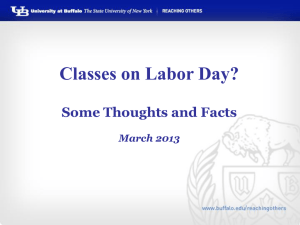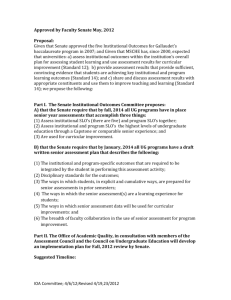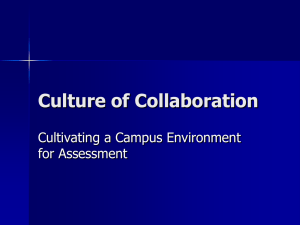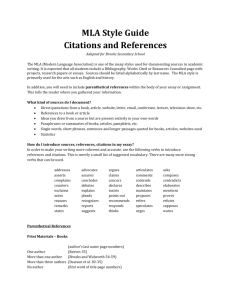eLearning 9 Hallmarks Gap Analysis
advertisement
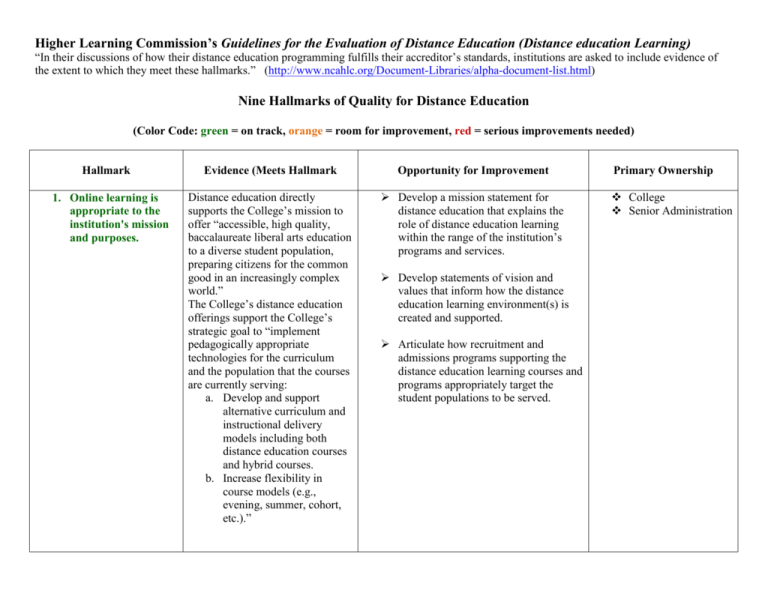
Higher Learning Commission’s Guidelines for the Evaluation of Distance Education (Distance education Learning) “In their discussions of how their distance education programming fulfills their accreditor’s standards, institutions are asked to include evidence of the extent to which they meet these hallmarks.” (http://www.ncahlc.org/Document-Libraries/alpha-document-list.html) Nine Hallmarks of Quality for Distance Education (Color Code: green = on track, orange = room for improvement, red = serious improvements needed) Hallmark 1. Online learning is appropriate to the institution's mission and purposes. Evidence (Meets Hallmark Opportunity for Improvement Distance education directly supports the College’s mission to offer “accessible, high quality, baccalaureate liberal arts education to a diverse student population, preparing citizens for the common good in an increasingly complex world.” The College’s distance education offerings support the College’s strategic goal to “implement pedagogically appropriate technologies for the curriculum and the population that the courses are currently serving: a. Develop and support alternative curriculum and instructional delivery models including both distance education courses and hybrid courses. b. Increase flexibility in course models (e.g., evening, summer, cohort, etc.).” Develop a mission statement for distance education that explains the role of distance education learning within the range of the institution’s programs and services. Develop statements of vision and values that inform how the distance education learning environment(s) is created and supported. Articulate how recruitment and admissions programs supporting the distance education learning courses and programs appropriately target the student populations to be served. Primary Ownership College Senior Administration 2. The institution's plans for developing, sustaining, and, if appropriate, expanding online learning offerings are integrated into its regular planning and evaluation processes. Faculty Senate provides strategic direction and planning over all academic programs and courses. 3. Online learning is incorporated into the institution's systems of governance and academic oversight. Faculty Senate provides strategic direction and planning over all academic programs and courses. 4. Curricula for the institution's online learning offerings are coherent, cohesive, and comparable in academic rigor to programs offered in traditional instructional formats. Sustainable funding for distance education is linked to the annual planning-achievement-budgeting cycle including the College’s annual fiscal allocation process. Departments/programs, that seek funding for distance education initiatives are required to submit an itemized budget request, as well as a justification for those requests tied to strategic plan goals and objectives. All budget requests are reviewed by the President’s Budget Committee. Faculty are responsible for the design and implementation of distance education courses. Document how the academic programs delivering distance education are responsible for the development and ownership of their offerings Document the College’s and distance education learning programs record of conducting needs analysis and of support of programs Develop an efficient process for Faculty Senate to review and approve distance courses and programs Develop a process to ensure the rigor the courses and quality of instruction Develop a process and document the evaluation of distance education courses and programs Faculty Senate Demonstrate the following: The curricular goals and course objectives show that the institution or program has knowledge of the best uses of distance education learning in different disciplines and settings. Curricula delivered through distance education are benchmarked against onground courses and programs. The curriculum is coherent in its Senior Administration Faculty Senate Budget IT Faculty Senate eLearning Director 5. The institution evaluates the effectiveness of its online learning offerings, including the extent to which the online learning goals are achieved, and uses the results Student Course evaluations are provided to all students regardless of delivery method content and sequencing of courses and is effectively defined in easily available documents including course syllabi and program descriptions. Scheduling of distance education learning courses and programs provides students with a dependable pathway to ensure timely completion of degrees. The institution or program has established and enforces a policy on distance education learning course enrollments to ensure faculty capacity to work appropriately with students. Expectations for any required face-toface, on-ground work (e.g., internships, specialized laboratory work) are stated clearly. Course design and delivery supports student-student and faculty-student interaction. Curriculum design and the course management system enable active faculty contribution to the learning environment. Course and program structures provide schedule and support known to be effective in helping online learning students persist and succeed. Develop a policy and process to assess student learning in distance education courses that follows the processes used for face-to-face courses. Develop a College assessment strategy to evaluate the effectiveness of academic and support services provided to distance education students. Faculty Senate Assessment Director of its evaluations to enhance the attainment of the goals. 6. Faculty responsible for delivering the online learning curricula and evaluating the students' success in achieve the online learning goals are appropriately qualified and effectively supported. Demonstrate the appropriate use of technology to support its assessment strategies. Document success in implementing changes informed by its programs of assessment and evaluation. Archive examples of student work and student interactions among themselves and with faculty. Demonstrate the following: Distance education learning faculty are carefully selected, appropriately trained, frequently evaluated, and are marked by an acceptable level of turnover. The College's training program for distance education learning faculty is periodic, incorporates tested good practices in distance education learning pedagogy, and ensures competency with the range of software products used by the institution. Faculty are proficient and effectively supported in using the course management system. The office or persons responsible for distance education learning training programs are clearly identified and have the competencies to accomplish the tasks, including knowledge of the specialized resources and technical support available to support course development and delivery. Faculty members engaged in distance education learning share in the mission and goals of the institution and its programs and are provided the opportunities to contribute to the Faculty Senate Department Chairs eLearning Director 7. The institution provides effective student and academic services to support students enrolling in online learning offerings. Students are provided with reasonable and cost-effective ways to participate in the institution’s system of student authentication. Student complaint processes are clearly defined and can be used electronically. broader activities of the institution. Students express satisfaction with the quality of the instruction provided by distance education learning faculty members. Work with Enrollment Management, Student Services and other Academic Support units to develop/define services for distance education learners. Library Tutoring Writing Center ADA Test proctoring Book store Advising & registration Etc. eLearning Director Enrollment Management Student Services Library Implement a 24/7 tech support service Document the following: The institution prepares a multi-year budget for distance education learning that includes resources for assessment of program demand, marketing, appropriate levels of faculty and staff, faculty and staff development, library and information resources, and technology infrastructure. 8. The institution provides sufficient resources to support and, if appropriate, expand its online learning offerings. 9. The institution assures the integrity Distance Education Student Verification through the College’s The institution provides evidence of a multi-year technology plan that addresses its goals for online learning and includes provision for a robust and scalable technical infrastructure. Provide training and assistance to faculty to design courses that employ Senior Administration Budget IT Faculty Senate eLearning of its online learning offerings. Central Authentication Service: In any distance education course reasonable steps are taken by the College to assure that each student who registers in the course is the same student who participates in, completes and receives credit for the course. (This is a federal requirement. All institutions that offer distance education programming must demonstrate compliance with this requirement.) assignments and evaluations unique to the course and that support academic integrity. Include issues of academic integrity during the orientation for distance education students. Add explicit references to distance education to academic integrity policy
